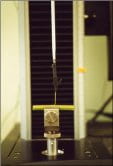Introduction

Hemp (Cannabis sativa) is widely grown for its fibres; it produces phloem fibres, which are formed in bundles towards the periphery of the stem. In order to remove the fibre from the stem it is left to decompose by the action of fungi and bacteria, this process is called retting. This study investigated one aspect of the retting process, the dissociation of these fibres from the core of the stem.
Methods

Peel tests were used to investigate the work required to remove a tissue peel, rich in fibres, from the core of the stem. Two separate experiments studied (1) the effects of tissue dehydration as stems were dried out in the oven; and (2) the progress of retting in stems that were dew-retted in the field.
Results

A comparison between two different types of peel tests, where the stems were clamped either vertically or horizontally in the jaws of a tensile testing machine and the load applied vertically, showed that the work required to peel stems in the vertical position was over 20% greater than that for the horizontal position.
Freshly harvested stems were dehydrated in an oven at 40°C over a period of 42 h and as the moisture content decreased there was a significant increase in the work to peel. In contrast, stems that had been dew-retted in the field showed a significant decrease in work to peel. When the moisture content of stems dried in the oven decreased below 12%, the work to peel rapidly decreased.

As the plant tissues dehydrated their fracture characteristics changed and this was reflected in the increase in the work to peel seen in the oven-dried samples. This, however, was not evident in the field-retted samples, in which there was a decrease in work to peel (Fig. 1). The field-retted samples were exposed to the activity of micro-organisms for a prolonged period of time compared with the oven dried samples; this increased the potential degradation caused by microbial enzymes. Thus, the reduced work to peel in dew-retted stems is thought to be due to the colonisation of the stem by micro-organisms and the subsequent retting process. The dramatic decrease in work to peel at low moisture content in the oven-dried stems is thought to result from mechanical changes leading to brittle fracture characteristics.
Conclusion
This study indicates that peel tests can be used to objectively monitor the reduction in work to peel for dew-retted stems and relate this reduction to the progress of retting. Thus, peel tests may be used to monitor the effects of different factors on the process of retting in hemp (Booth and Goodman, 2003; Booth et al., 2004).
